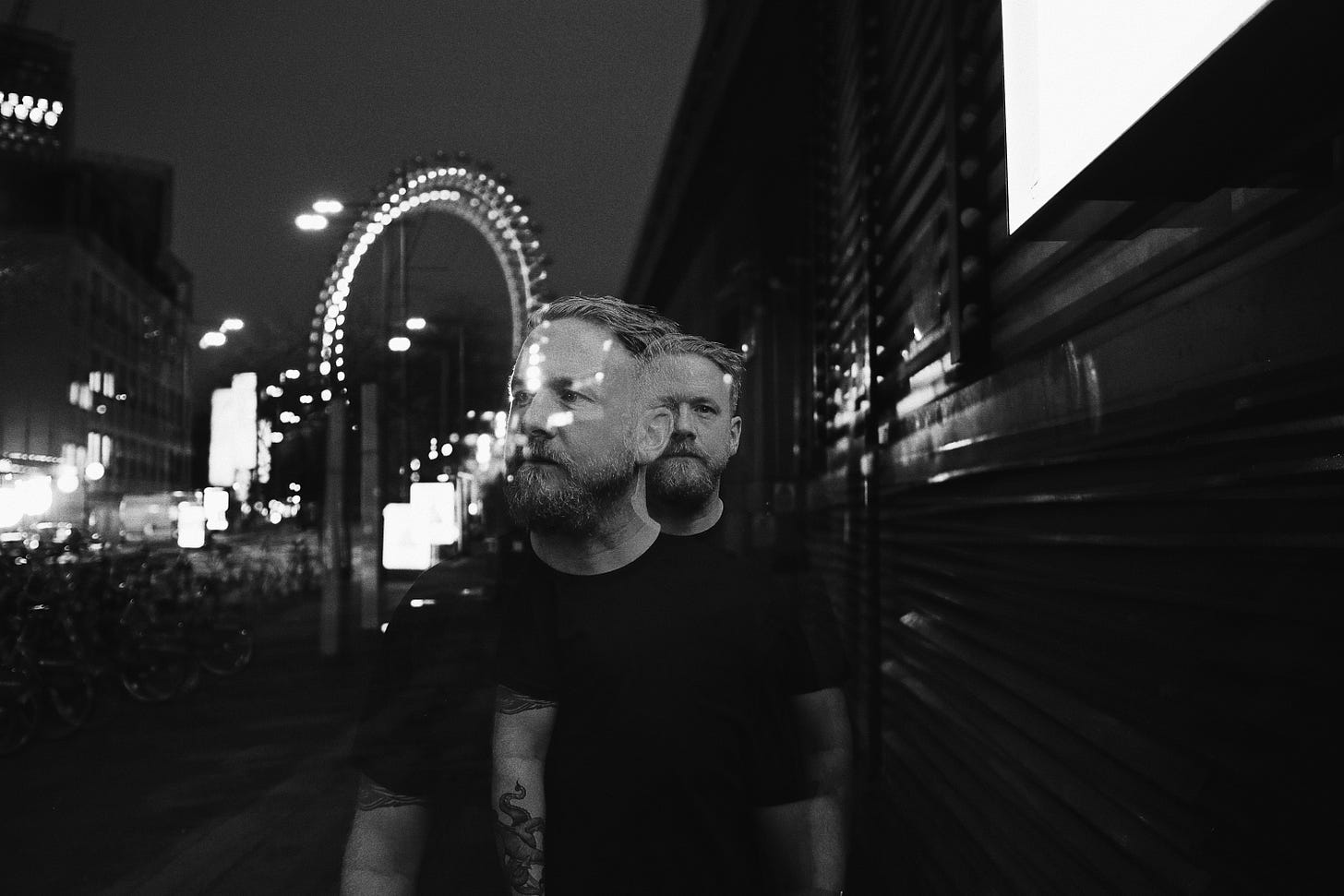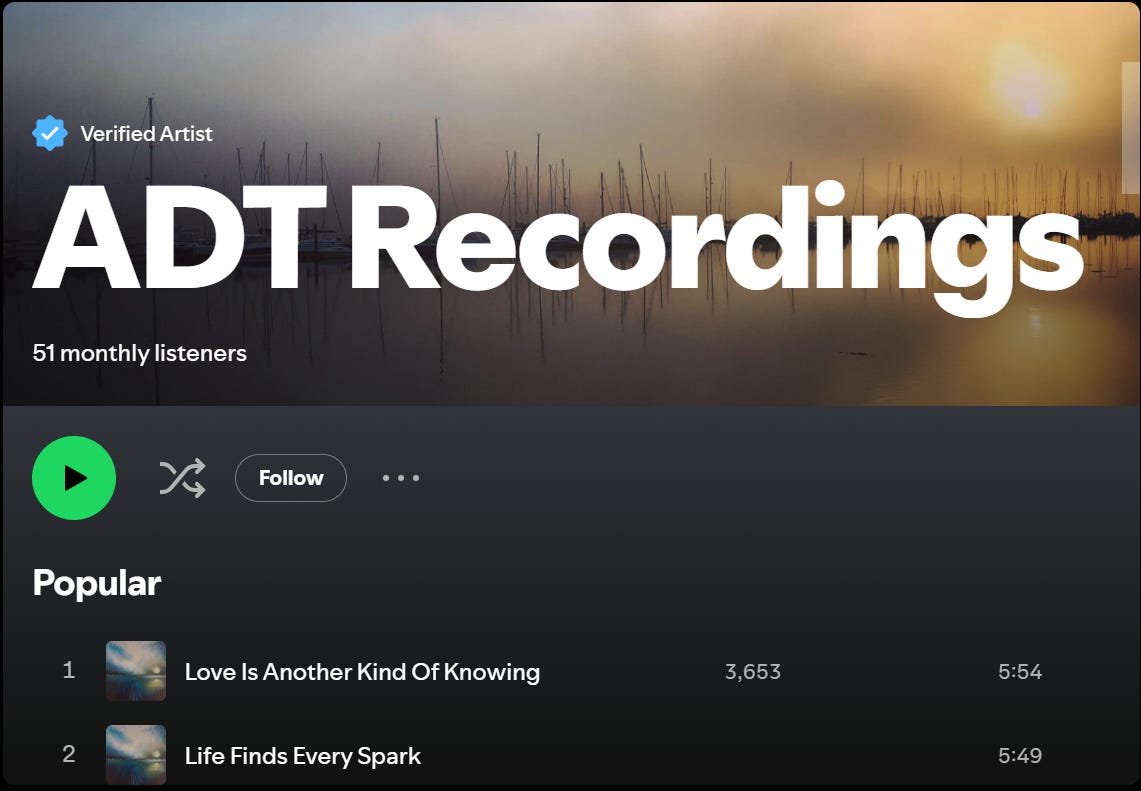This week, I caught up with Alan Daniel Tobin to talk songwriting, collecting sounds and lighthouses.
“We could be on holiday and we could be at a beautiful beach and like I'd be taking pictures of a crack in a footpath,” Alan laughs.
For the Carrigaline-based musician, artistic inspiration can be sourced from anywhere: a thump on the Luas track, snatches of conversation, or the howling of seagulls flocking around a lighthouse.
This snippets of the world, urban or natural, seep through his songs, interwoven with lyrics or melody, evoking memories or colouring in the scene.
“There's a lot of stuff in my solo stuff regarding field recordings,” Alan says. “I bring an H4, which is this little mini recorder, with me everywhere. It just adds that bit of a time stamp or kind of takes you away to another place.”
“I'm recording sounds of places where I've been because, I suppose like if nothing else, I'm recording music or even documenting music for myself initially, but it's almost like a legacy for my children,” Alan reflects.
“If something happened in the morning, at least they have this little piece that they can hear and listen to it anytime.
“If you have little field recordings and you know that it'll almost put a timestamp on where this song was created or even where the original idea came from.”
Raised in Ardfield, the Clonakilty native has a grá for the ocean, and an intrigue with the tall solitary guideposts of lighthouses.
“I would be influenced a lot by the sea,” Alan says, “last year I did a tour of lighthouses.”
“First of all, I asked Great Houses or Irish Lights if it was possible to play music at some of the lighthouses,” Alan explains. “So, they gave me a list of eight lighthouses that they have visitors. You know that you're not going to risk your life trying to get to them.”
“So, I curated a tour around six light houses where they had visitor centres and there was a maritime festival at the same time, and then I raised money for the RNLI as well,” Alan says. “So, there was a nice little package going last year, which I'm hoping to do again next year.
“There I would have gathered a lot of field recordings of the sea, birds, and wildlife. I will use it at some stage. But you kind of put it in your little folder on your laptop and go, I'll come back to that when I need it.”
It’s these nuances and personal moments that distinguish Alan’s solo music from some of his other work in the music industry throughout the years.
He traces his interest in music back to seeing his older cousin rocking out on the guitar to Michael Jackson or Guns N’Roses, and from listening to - and watching - his records.
“It was cool just to see the vinyl and to see it turning, it was just fascinating, just thinking that music would come from this thing that would spin, you know? So probably that's where the fascination came from,” Alan reflects.
He remembers his mom buying him a guitar in Pro Musica and taking lessons which he had no patience for, but finding his passion in the thriving grunge scene: “we were crazy into Nirvana and Pearl Jam and Soundgarden and all the grunge scene at the time.
“And those songs were pretty easy once you knew the bare chords, they were pretty much easy to at least sing along to.”
The grunge influence bled into the music of his secondary school bands, “a lot of it was all our own kind of reinterpretations of the grunge rock scene at the time”, before unearthing the urban sounds of electronic music in college: “I was always, I suppose, writing and recording bits of my own material.”
With the foundations of rock and grunge, and new influential layers of electronic and synth, Alan’s music transitioned into a more “acoustic-based” sound post college: “I would have gone into kind of alt-country folk. Singer-songwriter stuff like, obviously, Damien Rice would have been a big influence. Damien Rice, the old school Neil Young, David Bowie. I kind of went back to the 60s and 70s.”
After setting up a band, Saint Bourbon, in his hometown of Clonakilty, Alan left for Australia. “I would have brought the guitar with me, so I would have been writing a lot of solo stuff.”
Upon his return in 2007, Alan began working for the Southern Star newspaper. “I had a kind of a bank of songs that I wanted to record when I came back and I met up with Neil in the Southern Star.”
“We would have got together at lunchtime in his house over a cup of tea and would have jammed on these songs that I would have written when I was either in Australia or on the road. And we formed Low Mountain.”
Low Mountain, composed of the duo - and later, the addition of Deirdre Archbold - recorded two albums and toured across Ireland and further afield, touring twice in the Czech Republic, where they caught up with Marketa Irglová and Glen Hansard.
“We had full time jobs, so it wasn't as if we could go on big, extensive tours,” Alan reflects. “Maybe we'd go for a week, but a solid week of gigs and festivals and stuff like that. And most video we did, we played Other Voices.”
The pandemic gave Alan an opportunity to pursue some solo ventures: “Pre-COVID I'd spoken to this producer that I wanted to work with. His name is Justin Grounds.
“He lives down in Clonakilty, but he's an English electronic folk artist, so it's the electronic kind of ambient orchestration that I wanted to get into next, more soundscapes and almost soundtracks for movies,” Alan says.
“So, I went and recorded two albums with Justin - solo albums.”
The process of creating these solo bodies of work differed from the experience of hammering out tracks in a band, bouncing ideas around and emeshing creative visions: “in a band, obviously you have people's creative views and I suppose constructive views on the song that you're working on.
“When you're working solo, it's entirely up to yourself,” Alan continues, “which is a good thing too, because you have full control over it. So, there's a bit of freedom being a solo artist, but still you miss that creative out or input from another source.
“But then I suppose, I did work with Justin, so he was my sounding board. Like, I couldn't imagine being cooped up in a room and doing everything.”
“I would have recorded the stuff here at home, just a rough vocal and the guitar line and then I would send it to Justin as some sort of a reference point there for him,” Alan describes.
“So, he'd tear it all apart and he'd put it back together in a nice, beautiful piece of audio.”
Though the seeds of the songs were planted at homes, they flourished through the producing process, elements of the natural world cropping up in many of the tracks.
“If it's in tune and there's a bit of emotion or it's not too clinical, it's not too produced, then that works for me because those – not flaws - but the little nuances in someone's voice make it what it is.”
“It's a little thing that works off each other,” he says, “like you have the natural instruments, the natural world, and then you have this electronic music as well.
“In some songs they work together, but then they cause tension in others. Maybe a necessary tension.”
The songs on Alan’s solo albums are complex, invigorated with dizzying and soaring outros, teeming with a sense of longing, nostalgia, and love, accentuated by the potent emotion in his vocals.
“I do love a kind of a long textured outro,” Alan admits. “I love soundscapes because, I suppose, when I’m writing music, I would have a visual in my head as well.”
“There's a song on the first album called the Consequences of Breaking The Heart. A friend of mine, Sean O'Connor, had a short film script at the time, and when he heard the song it matched his short film script,” Alan recalls.
“So we decided to do a short film version, but without any script, without any words.”
For the graphic designer, amateur filmmaker and photographer, moving into the field of film scoring has been a creativity fluid transition: “The marrying of film and music is just brilliant.”
“I suppose I've been in the music industry, a good 20 years or more, but now it's like the amenities that you can have,” Alan reflects. “You can pretty much record an album on your iPhone or on your laptop, the creative sense is enhanced. And I'm not saying that ‘oh anyone can do it’, but people who can do it have that capability.”
With a substantial career, from supporting some of Ireland’s most treasured names in music (Mick Flannery, John Spillane and Glen Hansard to name but a few), to being an honorary member of Interference, to actually holding Marketa’s Oscar for ‘Falling Slowly’ in his hands, the dad of three is no stranger to the creative field.
“I'm trying to remember the songs I'm playing to my kids,” he says, recalling his musical influences. “They love the Beastie Boys and Daft Punk. And they love Nirvana. So, outside of all the Disney musicals, it’s back to earth with the grunge and the rock'n'roll.”
With upcoming projects in the works, such as the Your Roots Are Showing folk showcase event, Alan is also looking forward to returning to lighthouses: “I'm actually playing at a private function for the Great Lighthouses of Ireland.”
“They're trying to enhance lighthouse tourism, get people to visit their local lighthouse. It's the history, they’re just amazing places and stories. I'm looking forward to meeting all the lighthouse enthusiasts.”
You can listen to Alan’s most recent album Volume Two by ADT Recordings on Spotify.




